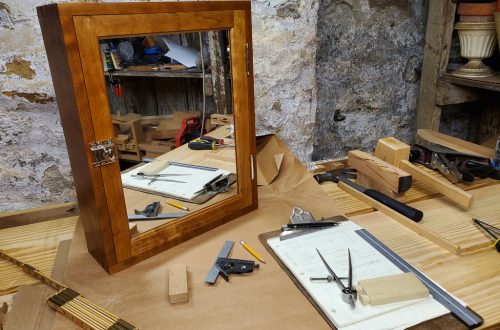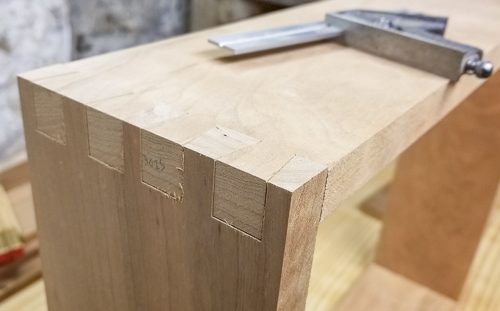New Stove Continued
I simply ran out of time when I was writing my last entry, then I got busy with a bunch of stuff. Now here I am with some time on a fine Saturday evening. So here continues the tale of the new stove.
When we last left our intrepid first-time stove installer (me), I was getting back to work after getting home. I was able to get some good work done, and then it was time to turn my attention back to getting the stove installed.
There were a number of tasks ahead:
- Install new electric outlet.
- Clean-up gas stub-out.
- Install new gas shut-off valve on stub-out.
- Install new flow limiter after the shut-off valve.
- Install new flexible hose to connect stove.
That’s a lot of stuff to do!
I got to work on the electrical outlet first, to cut down on the issues of potential sparks and the like after I worked with the gas piping. The old outlet came out easily enough, and its box was in OK condition. I had done a little bit of investigation, and found that, fortunately, the outlet behind the stove was a single stub circuit, so I didn’t have to worry about what else tied into it, or running a new breaker and pruning this stub from any knob and tube backbone, or anything like that. It was easy. I taped the new 12/3 romex to the old cloth-and-tar 12/2 cable, and then went downstairs to pull that through. I hit a tiny bit of resistance while pulling, then found myself holding the entire bit of old cable with NONE of the new cable. Doh. I grabbed a flashlight to peer up into the joists where the cable went through an angled hole in the sill plate. I saw the trailing edge of the electrical tape, so I knew that the new cable had at least gotten that far. I wasn’t going to spend all night with this, though, so I grabbed my fish tape and ran that up through the hole into the wall cavity, then went upstairs and pulled that through the outlet box hole and re-attached the new cable to that. Back downstairs, I was able to easily pull the new cable through the angled hole with the fish tape, and joy was restored.
The existing breaker was 15A, and was the recommended circuit rating by the stove manufacturer, so I just re-used it. It was also practically brand new, since we just had the service installed recently. I terminated the outlet upstairs first and got it put back into its box, then went back downstairs to terminate the line in the main panel. I ran that neatly, terminated it, and flipped the breaker for a smoke test. Yay! No smoke! I switched it off again, just in case something bad happened while I was working on the gas piping.
Next up was the gas piping. I used thread tape to install the shut-off valve, then found that the dork at Lowe’s didn’t sell me the right one. It has a female 1/2″ exit fitting, which doesn’t work with the hose kit they sold me, which needed either a male 1/2″ exit fitting, or a female 3/4″ exit fitting. Argh. Well, I decided to make things as safe as they were before, and to install the correct valve later instead of trying to make this work with a barrel fitting or some other concoction. So the new valve came off of the stub-out, and the flow limiter went on (with new thread tape, of course). The flow limiter came with the flexible hose kit, and is designed to cut-off the flow of gas in the event of a rupture in the flexible hose or other calamity that would cause a dangerous release of gas. Good stuff.
The flow limiter had a built-in taper fitting, so one end of the flexible hose connected to that. The other taper fitting was first installed into the stove with thread sealant that came with the hose kit, then the other end of the flexible hose was connected to that.
I went into the basement to open the valve that feeds the stove stub-out. That was pretty uneventful. Back upstairs, I applied the supplied leak test goo to all of the fittings, then watched for bubbles. No bubbles. All good. I cleaned off all of the goo, and then went back downstairs to turn on the stove outlet breaker again.
Back upstairs, I installed the anti-tip bracket on the floor, using the template supplied with the stove. My first attempt put it a little closer to the bathroom door than I had intended, so I moved it over a few inches and re-installed it. Easy. I then pushed the stove onto the bracket making sure that the fancy new flexible hose didn’t get crimped out of control, and making sure that the electric cord for the stove wasn’t crimped or damaged.
Turning the page on the install manual, the first step was to level the stove. Wahoo! Leveling feet that worked! This is the first time I’ve had a level cooking appliance since I moved out of my parents’ house. This did, however, indicate one major failing of my tool collection–I don’t have a large bubble level. I have a couple of small bubble levels, so I used one of those that I know to be accurate. I found that section of the floor to be way out of whack, which isn’t entirely surprising since it is one of the longest spans of floor joists in the house.
With the stove level, the next thing was to make sure all of the burner caps are in place correctly. Easy. Next thing was to test the burners and adjust them for minimum usable flame at the lowest control setting. Oooh. Fun. It said that the burners may take a little while to light the first time through, as the lines had to be purged of air after being connected to the gas line for the first time. I turned the valve for one burner to the light position, and waited. And waited. And waited some more. Then I turned it off. I thought maybe I didn’t have the service valve on the regulator turned on. While I was looking at the installation manual to figure out how to check that, I caught a slight whiff of gas. I turned the burner back to light again, and it lit in an instant! Woo hoo! Working flaming things! I went through each of the five burners to test them and then adjust the flame level at the lowest setting so that the burner wouldn’t go out when turned to its lowest setting. This only took a couple of minutes, as three out of the five burners were in good adjustment as-arrived.
Next in the installation manual was setup and test of the two ovens and broiler. I did the main oven first, which fired-up without any major issues, and the flame was of good quality. I then tested the broiler burner, which is located at the top of the main oven in this configuration. It also worked just fine. I installed the three racks (two nice ball-bearing pull-out racks, plus one standard rack) into some default positions. Lastly, I tested the lower oven, which has an electric burner. It came on with no problems, and started to come up to temperature. No problems there, so I shut it off and installed the rack for that oven in its tray.
The installation manual finished, I retired to the living room as a tired, exhausted, sore, and happy individual, and started to read the operating manual.
This story is why I never want to end up as an appliance installer. I’m far to anal and perfectionist when it comes to some of these things. I’m happy, though, and we have an awesome range now. I spent this weekend with Jenny cooking all kinds of things, and now we have a bunch of left-overs in the fridge to hold us until Christmas Eve. Happiness and Joy! Oh, for even more happiness and joy, I don’t have to be back in the office again until the week after New Year’s Day, thanks to holidays, floating holidays, working from home days, and two vacation days. Whew. I think I need the break.
jonathan


